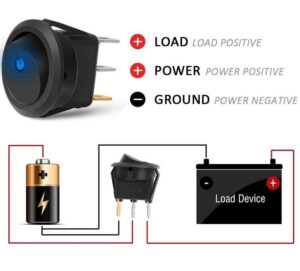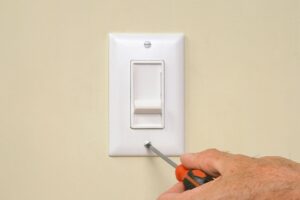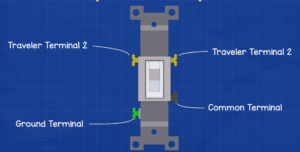Electronic switches are among the most essential components in your home’s electrical system and appliances. The primary purpose of these switches is to turn an electric circuit on or off.
The switch does this by interrupting the flow of electric current or letting it continue. There are several different types of switches available, with one of them being the toggle switch. And in this article, we will be taking a closer look at the toggle switch and discuss the process of how to wire a toggle switch with 3 prongs.
What is a toggle switch?
Firstly we need to understand what a toggle switch is. Sometimes referred to as joystick switches, these switches take the form of a lever or handle. And when the lever is moved forward, it opens the circuit, and when it is moved backward, it closes the circuit.
In this regard, a toggle switch controls the flow of current to a device or within it, for example, from the power supply to the device or appliance.
3 pin/3-way toggle switch features/specifications
Next, we need to consider the configuration and features of a standard 3-pin/3-way toggle switch. As its name suggests, this type of toggle switch has three pins or terminals. The three are typically labeled as power, acc, and neutral.
The power terminal is where the incoming power supply is connected to and acts as the hot wire of the circuit. The accessory or acc terminal connects to the appliance or device that turns on when the switch is turned on. The neutral terminal is where the neutral wire of the circuit is connected and is often labeled as N or –
- Voltage and current rating: The switch will typically have a current and voltage rating. These ratings indicate the maximum current and voltage it can handle. In most cases, the voltage rating is. The current rating will typically be 100mA for the gold and silver-coloured terminals.
- Switching speed: this refers to how quickly the toggle of the switch transitions from one position to another. When it comes to this speed, it will depend on the type of switch. On average mechanical switches have a slower switching speed than solid-state ones.
- When it comes to the operating temperature, it ranges from -30 to 85 oc.
- These switches have other specifications, including a maximum contact resistance of about 10Mohms and an insulation resistance of at least 1000 MOhms.
What are some typical applications of a 3-pin toggle switch
The 3-pin toggle switch is used in various areas, some of the most common being;
- Used in domestic, commercials as well as industrial power points
- They are used in various industrial and electrical equipment, such as conveyor belts and residual current devices.
- These types of switches are also used in controlling lighting fixtures in residential and commercial houses.
- They are used in large residential electrical appliances such as heaters, fans, air conditioning systems, and other kitchen appliances.
- It can also be used in the control of motors in small equipment.
Rocker vs Toggle Switches
Apart from toggle switches, there are also rocker switches. Both types of switches have the same functionality. As such, the two are interchangeable and are used in the same back boxes. However, there are some slight differences between the two.
One of these differences is the fact that toggle switches have a louder click when turned on/off than rocker switches. They also differ in regard to cost, as toggle switches tend to be costlier than rocker switches.
The two also differ in terms of appearance. The rocker switch has a more modern design and is what you will find in most residential homes. The toggle switch has a unique design, with some plastic toggle switches having a more retro appearance.
When replacing a toggle switch with a rocker switch or vice versa, you would need to replace the mounting yoke or faceplate.
how to wire a toggle switch with 3 prongs

Step One: Turning off power;
The first step in wiring a toggle switch with 3 prongs is to turn off the power. To do this, locate the main breaker and identify the breaker that supplies power to where you want to install the switch.
Check the LED indicators of the board to verify that there is no power to the area you are installing the toggle switch. Alternatively, you can use a voltmeter to check if the electric current is still flowing.
Step two: Remove the cover plate

The next step is to remove the cover plate if you are replacing one switch with another. Removing the cover plate gives you easy access to the wires. Furthermore, the new toggle switch may not fit in the place of the old one.
Use a screwdriver to remove the screws holding the cover plate. Then use a tiny flat-based screwdriver to pry it. Ensure that the wires do not have an electric current flowing.
Step three: Identify the switch terminals

Once you have access to the wires, it is essential to ensure you wire the switch to the correct terminal. The power terminal is where the positive wire should be connected. The ground/neutral terminal should be connected to the neutral/ground wire.
The acc or accessories terminal should be connected with the positive wire of the electrical appliance you want to operate with the switch. In most cases, the neutral wire is usually the brass terminal, while the middle terminal is the accessory terminal. The other terminal furthest from the brass one is the power terminal.
Typically the wires to connect to the terminals are colored . The black wire should go to the neutral terminal, and the red wire to the power terminal.
Step four: Troubleshoot
Turn the power on in the main panel and check if the LED on the switch is turned on or off. If it is turned off, you need to recheck the wiring.
Necessary instruments
- A screwdriver to pry away the cover panel and remove its screws
- A voltmeter or multimeter for testing if there is any electric current flowing through the wires
- Wire strippers to remove the insulation from the ends of the wires for connecting to the terminals
- Electrical tape for insulating the wire connections.
Advantages and disadvantages of toggle switches
- Toggle switches have a simple design that makes them easy to understand and install.
- These types of switches are typically made from hard plastic or metal, which makes them robust and durable and can last for long.
- They are versatile and can be used in a wide array of appliances and electrical equipment.
- These types of switches offer a reliable and stable connection and are usually consistent.
Disadvantages
- These switches offer only two positions on and off. They are thus not ideal where intermediate or adjustable positions are needed.
- They have a limited current rating and voltage. They may not be ideal for certain high-power electrical equipment or appliances.
Frequently Asked Questions
Can I switch from a rocker to a toggle switch?
Yes, these two types of switches can be used interchangeably, and you can replace one with the other, as the case may be.
Can I use a toggle switch in large applications?
Toggle switches are suited for low-voltage applications and are not suited for some larger high-power applications.
Conclusions
Toggle switches are common and used in residential and commercial settings. They are easy to install and operate and work well with low-voltage applications. In terms of usage, they are also used in cars and lighting fixtures.
